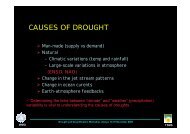Slayt 1 - RTC, Regional Training Centre - Turkey
Slayt 1 - RTC, Regional Training Centre - Turkey
Slayt 1 - RTC, Regional Training Centre - Turkey
You also want an ePaper? Increase the reach of your titles
YUMPU automatically turns print PDFs into web optimized ePapers that Google loves.
Representing the Forecast VariablesConceptually, spectral models emulate the process of drawing contours through a data field torepresent the forecast variables. Instead of using grid points, they use a combination of continuouswaves of differing wavelength and amplitude to specify the forecast variables and their derivatives at alllocations (not just at grid points).Consider, for example, the process of drawing contours through the same data shown in the grid pointgraphic for use in a two-wave model.Now, the model has added detail by including two sets of local increases and decreases (+ and - areas,respectively) to the "first-guess" contour. In effect, the model has defined a second set of waves with ashorter wavelength and smaller amplitude (two sets of more subtle variations stretching around theglobe, indicated by the positive and negative departures from the first wave), which complete themathematical description of this data set for this two-wave model.Since spectral models represent some of the forecast variables with continuous waves (a combinationof sines and cosines) rather than at separate points along a wave, they can use more accurate numericaltechniques to solve some of the equations and much longer forecast time steps than the finitedifference techniques used by grid point models. The larger time step compensates for the addedcomplexity of the computations required to solve the trigonometric functions. Since some grid pointcalculations are required in spectral models, some computational errors associated with grid pointmodels will still be present.
















